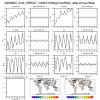Hi,
I am using the SpinupStability_v10.ncl from here question about CLM5 spin up to check if my AD spinup has reached equilibrium or not. The spinup was run with CLM5 from cesm5.1dev118, using sparse grids. I have several questions regarding the correct usage of this tool:
My AD spinup results were saved in monthly frequency, with 12 months in each history file (hist_nhtfrq = 0 hist_mfilt = 12). The tool ran successfully with 'annual_hist = True', even though the data are monthly mean values. Here is the statement at the beginning of the code: "This version operates on either monthly mean or multi-annual mean multi-variable history files." My understanding is that this tool is designed for h0 file saved with hist_mfilt = 1 (one sample in each historical file). Q1: Therefore, I am not confident whether this code run correctly with 'annual_hist = True' in my case with hist_nhtfrq = 0 , hist_mfilt = 12.
Here is the EQUILIBRIUM SUMMARY and the plots
(0) =======================================================================
(0) TOTECOSYSC is in equilibrium. Eq. Yr. = 1
(0) TOTSOMC is in equilibrium. Eq. Yr. = 1
(0) TOTVEGC is in equilibrium. Eq. Yr. = 1
(0) FATAL: TLAI is NOT in equilibrium
(0) GPP is in equilibrium. Eq. Yr. = 281
(0) WARNING: TWS is NOT in equilibrium or is missing
(0) WARNING: H2OSNO is NOT in equilibrium or is missing
(0) FATAL: Not enough of the land surface is in equilibrium ( 96.55% > 3.00%)
(0) FATAL: Your simulation is not in equilibrium, 8 hours have been deducted from your PTO bank, try again

The number of land surface areas not in equilibrium is so large. Q2: I would like to ask if it is reasonable for the values to deviate so far from equilibrium after 281 years.
The colored area in the last two maps from the tool did not match the area of my simulation. Q3: Could this be because my model is using sparse grids?
Another question is related to the tool's design for Global, Arctic, SPT. Q4: How can I use this tool for sparse grid simulations?
My understanding is that we need to change the threshold for various equilibrium to modify it for sparse grids. However, that means the thresholds will vary with different sparse grids in different simulations. Can we modify the tool so that it calculates the thresholds as a percentage of some sparce-grid value?
Thank you so much for any help!
I am using the SpinupStability_v10.ncl from here question about CLM5 spin up to check if my AD spinup has reached equilibrium or not. The spinup was run with CLM5 from cesm5.1dev118, using sparse grids. I have several questions regarding the correct usage of this tool:
My AD spinup results were saved in monthly frequency, with 12 months in each history file (hist_nhtfrq = 0 hist_mfilt = 12). The tool ran successfully with 'annual_hist = True', even though the data are monthly mean values. Here is the statement at the beginning of the code: "This version operates on either monthly mean or multi-annual mean multi-variable history files." My understanding is that this tool is designed for h0 file saved with hist_mfilt = 1 (one sample in each historical file). Q1: Therefore, I am not confident whether this code run correctly with 'annual_hist = True' in my case with hist_nhtfrq = 0 , hist_mfilt = 12.
Here is the EQUILIBRIUM SUMMARY and the plots
(0) =======================================================================
(0) TOTECOSYSC is in equilibrium. Eq. Yr. = 1
(0) TOTSOMC is in equilibrium. Eq. Yr. = 1
(0) TOTVEGC is in equilibrium. Eq. Yr. = 1
(0) FATAL: TLAI is NOT in equilibrium
(0) GPP is in equilibrium. Eq. Yr. = 281
(0) WARNING: TWS is NOT in equilibrium or is missing
(0) WARNING: H2OSNO is NOT in equilibrium or is missing
(0) FATAL: Not enough of the land surface is in equilibrium ( 96.55% > 3.00%)
(0) FATAL: Your simulation is not in equilibrium, 8 hours have been deducted from your PTO bank, try again

The number of land surface areas not in equilibrium is so large. Q2: I would like to ask if it is reasonable for the values to deviate so far from equilibrium after 281 years.
The colored area in the last two maps from the tool did not match the area of my simulation. Q3: Could this be because my model is using sparse grids?
Another question is related to the tool's design for Global, Arctic, SPT. Q4: How can I use this tool for sparse grid simulations?
My understanding is that we need to change the threshold for various equilibrium to modify it for sparse grids. However, that means the thresholds will vary with different sparse grids in different simulations. Can we modify the tool so that it calculates the thresholds as a percentage of some sparce-grid value?
Thank you so much for any help!
